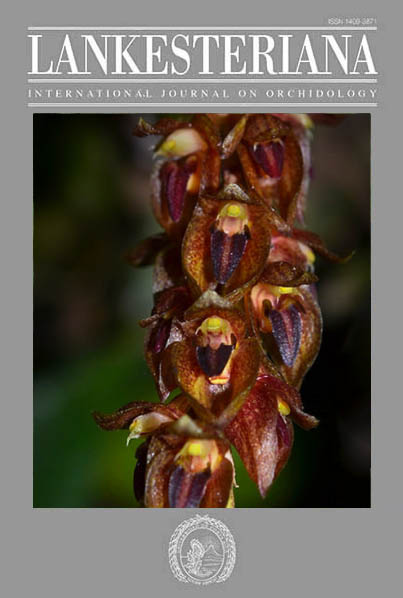Vegetative anatomy of the orchid <i>Bulbophyllum sterile</i> (Orchidaceae: Epidendroideae)
DOI:
https://doi.org/10.15517/lank.v18i1.32701Abstract
The anatomical characteristics of leaf, pseudobulb, and root of Bulbophyllum sterile of the subfamily Epidendroideae (Orchidaceae) were investigated. The anatomical investigation involved observing sections after staining with different stains as well as scanning electron microscopy. Additionally, the cell dimensions were also measured. The amphistomatic leaves of B. sterile had a thick cuticle, paracytic type of stomata, collateral vascular bundles and starch grains. The rhizome had cuticularized uniseriate epidermis and a single layer of the hypodermis. The parenchymatous stem ground tissue was distinguished into outer and inner regions separated by a band of sclerenchymatous tissue. Collateral vascular bundles were distributed in the inner ground tissue. The size of the vascular bundles generally increased from the periphery towards the center. A sclerenchymatous patch covered the phloem pole, whereas the xylem is covered by thin walled parenchymatous cells. The outer surface of the pseudobulb is covered by a thick cuticle. The parenchymatous ground tissue consisted of starch grains, aeration, water and algal cells and scattered collateral vascular bundles. Sclerenchymatous cells covered the phloem pole, whereas the xylem is covered by thin-walled cells. The velamen in B. sterile is single layered consisting of highly elongated compactly arranged cells. Uniseriate exodermis is dimorphic consisting of long and short cells. Cortical cells are differentiated into exodermis and endodermis. The O-thickened endodermal cell layer is interrupted by thin walled passage cells. Pith is sclerenchymatous. From this study, it can be concluded that B. sterile possess anatomical adaptations to xeric conditions in all the vegetative organs.
Downloads

Downloads
Published
How to Cite
Issue
Section
License
According to the Open Access policy promoted by the University of Costa Rica, all the papers published by Lankesteriana are licensed under the Creative Commons copyright and can be downloaded free of charge. The journal holds copyright and publishing rights under the CC BY-NC-ND 3.0 CR license.
Before the publication of the materials submitted by the author(s) in LANKESTERIANA, the author(s) hereby assign all rights in the article to the Lankester Botanical Garden.




